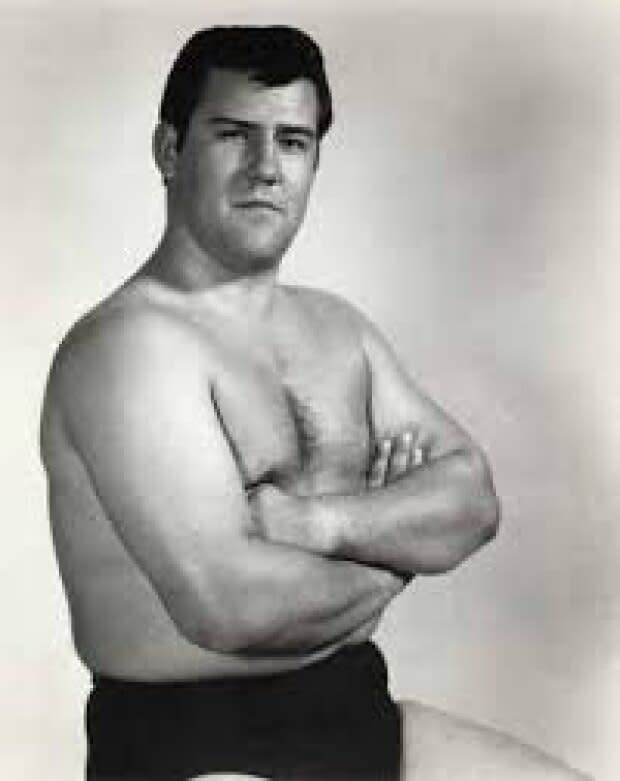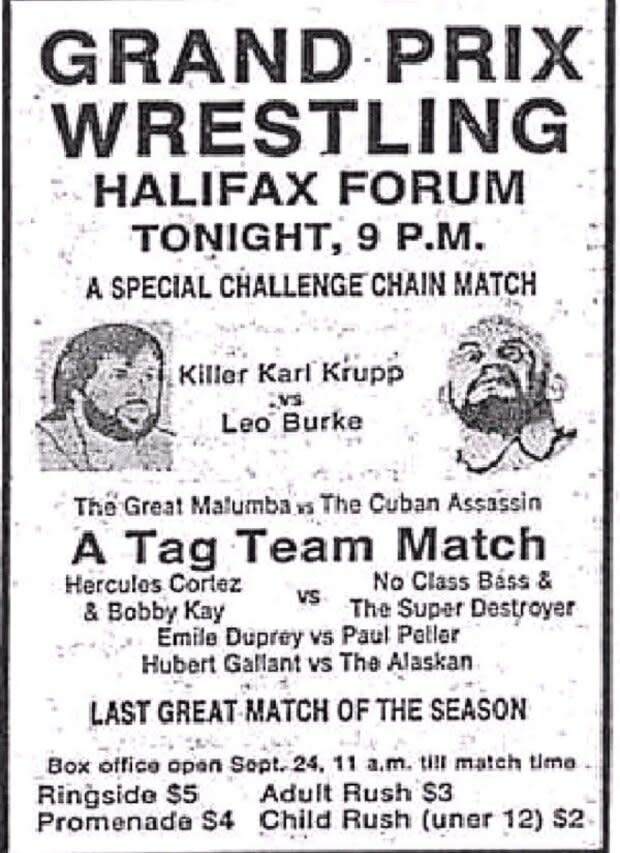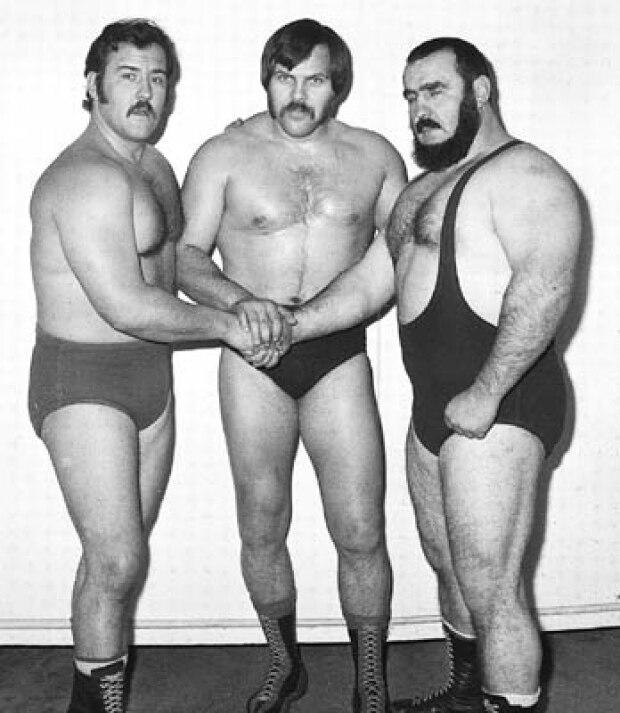Romeo Cormier's alter ego Bobby Kay helped define 'golden age of Maritime wrestling'
In the world of professional wrestling, there are two types of wrestlers: "faces" and "heels."
That's wrestling lingo for white hats and black hats, heroes and villains, good guys and bad guys.
And Memramcook's Romeo Cormier, who starred in the wrestling game as Bobby Kay in the 1970s and '80s, was definitely a "face," both in and out of the ring.
"Well, I mean, he was a nice guy." said wrestling writer Greg Oliver, who met Bobby Kay during a hometown celebration of the famous Cormier brothers.
"Bobby wasn't a braggadocio guy at all."
Romeo Cormier died Jan. 17 at the age of 70.
But Bobby Kay lives on in the minds of those people who remember spending Saturday afternoon in front of their TV sets for Atlantic Grand Prix Wrestling, long before the days of simulcasting and pay-per-view.

The youngest member of the wrestling Cormier brothers, Bobby Kay often teamed up with Rudy Kay (Jean-Louis Cormier), Leo Burke (Leonce Cormier) and the Beast (Yvon Cormier) to do battle with assorted "heels" in the ring.
In fact, Oliver said the four would often all take part in introducing a new villain.
"So, the new bad guy, Archie (the Stomper) Gouldie may come in, and then he beats Bobby Kay, and then he meets Rudy Kay, but it's a tougher fight, but he beats Rudy," said Oliver.
"Then he has a real tough go with, you know, Leo Burke, and that feud goes on for two, three weeks. And, then, of course, at the end, he has to face the Beast, the mad man, 'How's he going to survive this?'"
"They didn't promote them as brothers, but everyone knew," Oliver said.

The Cormiers were members of a big Acadian family, 11 children in all, eight brothers, three sisters raised on a farm in the southeastern New Brunswick community of Memramcook.
But in the ring, they were always introduced as being from nearby Dorchester, likely because the prison there made the place better known to Maritimers.
Romeo followed his brothers into the wrestling game at a young age, heading to Calgary to train at 17.
In the late 1960s, Stu Hart's Stampede Wrestling was the place many wrestling hopefuls headed. They would train at Hart's school, known as "the Dungeon," a better name than "Stu's Basement," which is what it really was.
Hart was known for his punishing training techniques, but Oliver said the few moves Cormier learned there were far less important than the exposure Hart could offer.
"The fact is that you learn more on the road than you do in somebody's basement," Oliver said.
"He gave them a chance to perform, right, to actually go out and test your skills and get better at things. If he didn't have access to that, then you're training in a void."

He spent two years wrestling with Stu Hart's organization, under the name Norton Jackson.
But the Maritimes beckoned, as wrestling had become a big hit here.
Every summer, there were regular weekly stops on the East Coast scene.
Monday night, Moncton. Thursday night, Halifax. Saturday night, Berwick, N.S., and later, New Glasgow.
He went and got a real job, with a pension, you know, support a family. - Greg Oliver
The other cities and larger towns also got to see at least one night of wrestling each season.
And the Cormier brothers were a big part of those shows.
In 1969, their agent Al Zinck set up the Eastern Sports Association in partnership with Jean-Louis Cormier.
From May to October, the brothers would wrestle in a different community each and every night, seven days a week through most of the 1970s.

It wasn't an easy life.
"Back in the day, for sure, the guys like Leo made a living out of it, " Oliver said, "He travelled, he went around, he knew how to stay fresh and move somewhere else, which is, of course, key to the whole business right."
"You can really get burnt out."
Then there's the wear and tear on his body. At five feet nine inches tall and 220 pounds, Romeo Cormier was built to take the punishment of the falls and body slams.
'Tough decision'
But in a business with no health care, no trainers and no doctors, injuries were common.
"Bobby knew enough that, you know, 'I'm never going to dedicate my life to this the way, you know, Leo did," Oliver said.
"And he went and got a real job, with a pension, you know, support a family."
"A lot of guys had to make that decision along the way and it was obviously a tough decision because there's a lot of joy to being on the road," Oliver said.
"There's a lot of, you know, pain and heartache, too."
Cormier also had a second performing love: country music.
A singing wrestler
He would often play and sing songs during the interview portions of his wrestling career, and it became part of the character of Bobby Kay.
"This guy's got a guitar, he can strum, he must be a good guy," Oliver said. "So I think that was a big part of Bobby sticking in people's memory, too."
So much so that Cormier would go on to front the Bobby Kay band. His wrestling name followed him into his music career. And he was good at it, playing clubs regularly in Moncton, when he wasn't at his grocery business day job.
But he didn't really leave the game entirely, making several comebacks and special appearances with his brothers.

Robert Maillet grew up watching the Cormier brothers wrestling on TV in his hometown of Sainte-Marie-de-Kent.
In 1990, he began his wrestling career on a summer tour of Atlantic Grand Prix wrestling.
The Cormier brothers, including Romeo, were part of that tour.
"They opened their arms to me," Maillet said, "So I listened to them, I opened my ears to them."
'Golden age of wrestling'
"I do remember Romeo as a gentleman, you know, in how he conducts himself in the ring.
"I tried to learn from the best."
Romeo Cormier's death means Leonce is the only wrestling Cormier brother still alive. Jean-Louis died in 2008, and Yvon died in 2009.
"I would say they put the Maritimes on the map," said Maillet, who himself went on to a career in the World Wrestling Federation.
"It was the golden age of wrestling."
Oliver believes the Cormier brothers' willingness to stay in New Brunswick is a big part of why audiences have so much affection for them.
As proof, he points to Nova Scotia-born wrestler Rocky Johnson, who went to the U.S. to become a star.
"He's not celebrated the same way in Nova Scotia as the Cormiers are in New Brunswick because he didn't stay at home, right," Oliver said. "He wasn't on the screen bragging about being from Nova Scotia.
"So I think the Cormiers took that with them everywhere…they took this love and the celebration of the Maritimes with them."


